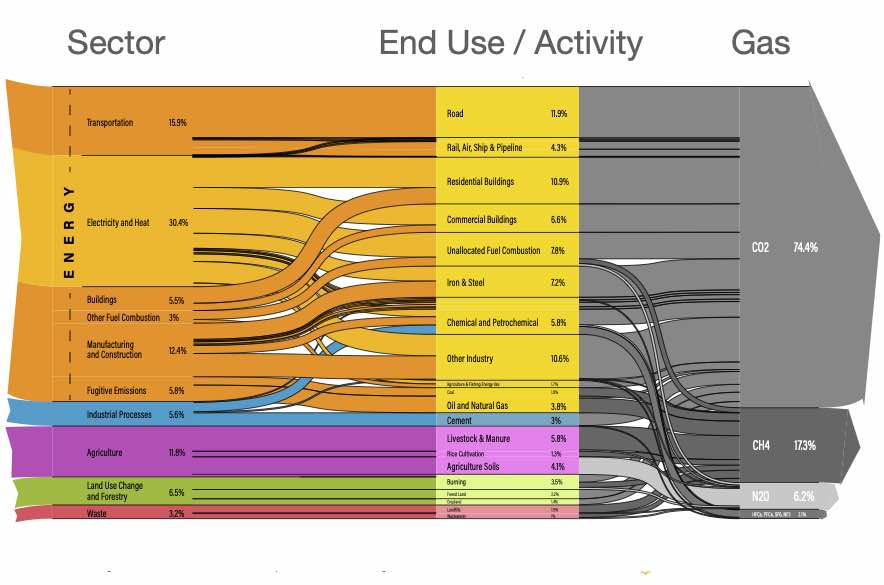
www.buildingsandcities.org/insights/commentaries/cop26-cross-sectoral.html
Transition to a Cross-sectoral Approach for Decarbonising the Built Environment

By Thomas Lützkendorf (Karlsruhe Institute of Technology, DE)
The sole reliance on a sectoral approach to GHG emission reductions is problematic and incomplete because it fails to engage with the complex array of built environment actors. A different conceptual and practical approach is proposed which involves 'areas of need' and 'areas of activity'. A scalable GHG budget for the built environment will be more effective in reducing built environment GHG emissions and allow actors to take more control over their emissions.
It is accepted that great efforts are needed to achieve a massive reduction in GHG emissions to net-zero. To do this effectively requires the definition and creation of GHG emission budgets for specific action areas and sectors. These budgets are necessary to develop reduction strategies and to introduce control mechanisms, (legal) requirements and incentives. This also applies to the construction, refurbishment, operation and use of construction works of all kinds, including buildings. This process is currently taking place in some countries. My expectation and hope is that the commitments made at COP-26 will lead to a scalable budget for the built environment that gives clarity to the many different actors involved and provides them with a clear set of metrics to achieve - both in the short and medium term.
The creation of a specific GHG emission budget for the built environment will not be easy. Indeed, the various inputs for its creation, operation and maintenance span many sectors which makes the accounting or allocation of emissions difficult. In a sectoral analysis, the allocation of GHG emissions is complicated for the construction and real estate sector because of its overlaps with the energy sector, the (construction product) manufacturing industry, the transport sector, waste management sector and, in some cases, agriculture sector. If the indirect emissions assigned to the energy sector are added to the direct emissions from building operation, the share attributed to the operation of residential and non-residential buildings rises to 25-30% of energy-related CO2 emissions (GABC et al., 2019). If the emissions from the manufacturing of construction products for new buildings and refurbishments are included, the share of all building-related activities based on international and national studies is around 40% of all energy- and process-related CO2 emissions (GABC et al., 2019). This suggests the true magnitude of the built environment's impact. But net-zero CO2-emission buildings are not enough to save the climate. In future we must include all energy- and process-related GHG emissions into such statistics as well as related strategies.
A thematic approach via macroeconomic sectors is often chosen but is problematic and incomplete because:
- the contribution and importance of the built environment are underestimated
- the involved actors are not clearly identified,
- the indirect emissions and their reduction potential are not considered.
In macroeconomics, buildings (and the built environment) are not a sector - the term 'building sector' is misleading (Habert et al, 2020).
If we consider the built environment as an object of assessment, this overcomes the difficulties associated with the sectoral approach. The responsibility and influence for construction, refurbishment lie with investors and owners, the operation resides with users. A promising alternative to the sectoral approach is to consider the construction, refurbishment and operation of buildings as an 'area of action' and the use of buildings, e.g. for residential purposes, as a service or 'area of need'. The consideration of the 'areas of need' shows references to the personal carbon budget (Fuso Nerini et al., 2021) and thus also makes the connections clear for individuals. It is therefore proposed to make greater use of these perspectives when designing and implementing reduction targets:
- the 'area of activity'
- the 'area of need'.
The 'area of activity' perspective is particularly suitable for influencing the direct and indirect GHG emissions associated with the construction, refurbishment and operation of buildings. It is possible to address and involve all actors along the value chain. In the spirit of SDG 12 (Responsible Consumption and Production), the suppliers and consumers of construction products, services and buildings can make their contribution to SDG 13 (Climate Action). It is not enough to manufacture low carbon products and implement net zero emission buildings; they must be accompanied by demand-side 'pull', finance and 'value'. The development taking place in Europe with respect to developing a taxonomy (European Commission, 2021) will address demand and finance by providing preferential financial investment to projects that contribute to sustainable development. Real estate financing is a major focus and taxonomy already calls for the determination of a carbon footprint for buildings. Research projects such as IEA EBC Annex 72 (IEA, 2021) are clarifying the methodological basis for its calculation as well as assessment. This complements various national and local activities in Europe. The cross-sectoral approach at the economic level corresponds to the analysis, assessment and decisions involving GHG emissions when designing new construction and refurbishment measures, taking into account a life cycle related environmental performance assessment.
Society urgently needs to supplement the traditional sectoral approach to GHG emissions with cross-sectoral activities. Researchers, NGOs and policymakers need to actively explain and recommend this internationally. This is the only way to tap the enormous potential for reductions by the many different actors along the value chain, but also by built environment 'consumers' (e.g. clients, owners and tenants). In the spirit of Graz Declaration for Climate Protection in the Built Environment (SBE19 Graz, 2019) there is a need for scalable targets on national, regional, national & institutional building stock, city and building level including budgets as guidance for design, funding and legislation.
References
European Commission. (2021). EU Taxonomy Compass. https://ec.europa.eu/sustainable-finance-taxonomy/activities/activity_en.htm?reference=7.1
GABC, IEA, UNEP. (2019). 2019 Global status report for buildings and construction: towards a zero-emission, efficient and resilient buildings and construction sector. https://bit.ly/3nOO2ff
Habert, G., Röck, M., Steininger, K., Lupisek, A., Birgisdottir, H., Desing, H., Chandrakumar, C., Pittau, F., Passer, A., Rovers, R., Slavkovic, K, Hollberg, A., Hoxha, E., Jusselme, T., Nault, E., Allacker, K., Lützkendorf, T. (2020). Carbon budgets for buildings: harmonising temporal, spatial and sectoral dimensions. Buildings and Cities, 1(1), 429-452. http://doi.org/10.5334/bc.47
IEA. (2021). IEA EBC Annex 72: assessing life cycle related environmental impacts caused by buildings. https://annex72.iea-ebc.org/
Fuso Nerini, F., Fawcett, T., Parag, Y., Ekins, P. (2021). Personal carbon allowances revisited. Nature Sustainability. https://doi.org/10.1038/s41893-021-00756-w
SBE19 Graz. (2019). Graz Declaration for Climate Protection in the Built Environment. https://gd.ccca.ac.at/
Latest Peer-Reviewed Journal Content
Net zero retrofit of the building stock [editorial]
D Godoy-Shimizu & P Steadman
Co-learning in living labs: nurturing civic agency and resilience
A Belfield
The importance of multi-roles and code-switching in living labs
H Noller & A Tarik
Researchers’ shifting roles in living labs for knowledge co-production
C-C Dobre & G Faldi
Increasing civic resilience in urban living labs: city authorities’ roles
E Alatalo, M Laine & M Kyrönviita
Co-curation as civic practice in community engagement
Z Li, M Sunikka-Blank, R Purohit & F Samuel
Preserving buildings: emission reductions from circular economy strategies in Austria
N Alaux, V Kulmer, J Vogel & A Passer
Urban living labs: relationality between institutions and local circularity
P Palo, M Adelfio, J Lundin & E Brandão
Living labs: epistemic modelling, temporariness and land value
J Clossick, T Khonsari & U Steven
Co-creating interventions to prevent mosquito-borne disease transmission in hospitals
O Sloan Wood, E Lupenza, D M Agnello, J B Knudsen, M Msellem, K L Schiøler & F Saleh
Circularity at the neighbourhood scale: co-creative living lab lessons
J Honsa, A Versele, T Van de Kerckhove & C Piccardo
Positive energy districts and energy communities: how living labs create value
E Malakhatka, O Shafqat, A Sandoff & L Thuvander
Built environment governance and professionalism: the end of laissez-faire (again)
S Foxell
Co-creating justice in housing energy transitions through energy living labs
D Ricci, C Leiwakabessy, S van Wieringen, P de Koning & T Konstantinou
HVAC characterisation of existing Canadian buildings for decarbonisation retrofit identification
J Adebisi & J J McArthur
Simulation and the building performance gap [editorial]
M Donn
Developing criteria for effective building-sector commitments in nationally determined contributions
P Graham, K McFarlane & M Taheri
Reimagining circularity: actions for optimising the use of existing buildings
R Lundgren, R Kyrö, S Toivonen & L Tähtinen
Effective interdisciplinary stakeholder engagement in net zero building design
S Vakeva-Baird, F Tahmasebi, JJ Williams & D Mumovic
Metrics for building component disassembly potential: a practical framework
H Järvelä, A Lehto, T Pirilä & M Kuittinen
The unfitness of dwellings: why spatial and conceptual boundaries matter
E Nisonen, D Milián Bernal & S Pelsmakers
Environmental variables and air quality: implications for planning and public health
H Itzhak-Ben-Shalom, T Saroglou, V Multanen, A Vanunu, A Karnieli, D Katoshevski, N Davidovitch & I A Meir
Exploring diverse drivers behind hybrid heating solutions
S Kilpeläinen, S Pelsmakers, R Castaño-Rosa & M-S Miettinen
Urban rooms and the expanded ecology of urban living labs
E Akbil & C Butterworth
Living with extreme heat: perceptions and experiences
L King & C Demski
A systemic decision-making model for energy retrofits
C Schünemann, M Dshemuchadse & S Scherbaum
Modelling site-specific outdoor temperature for buildings in urban environments
K Cebrat, J Narożny, M Baborska-Narożny & M Smektała
Understanding shading through home-use experience, measurement and modelling
M Baborska-Narożny, K Bandurski, & M Grudzińska
Building performance simulation for sensemaking in architectural pedagogy
M Bohm
Beyond the building: governance challenges in social housing retrofit
H Charles
Heat stress in social housing districts: tree cover–built form interaction
C Lopez-Ordoñez, E Garcia-Nevado, H Coch & M Morganti
An observational analysis of shade-related pedestrian activity
M Levenson, D Pearlmutter & O Aleksandrowicz
Learning to sail a building: a people-first approach to retrofit
B Bordass, R Pender, K Steele & A Graham
Market transformations: gas conversion as a blueprint for net zero retrofit
A Gillich
Resistance against zero-emission neighbourhood infrastructuring: key lessons from Norway
T Berker & R Woods
Megatrends and weak signals shaping future real estate
S Toivonen
A strategic niche management framework to scale deep energy retrofits
T H King & M Jemtrud
Generative AI: reconfiguring supervision and doctoral research
P Boyd & D Harding
Exploring interactions between shading and view using visual difference prediction
S Wasilewski & M Andersen
How urban green infrastructure contributes to carbon neutrality [briefing note]
R Hautamäki, L Kulmala, M Ariluoma & L Järvi
Implementing and operating net zero buildings in South Africa
R Terblanche, C May & J Steward
Quantifying inter-dwelling air exchanges during fan pressurisation tests
D Glew, F Thomas, D Miles-Shenton & J Parker
Western Asian and Northern African residential building stocks: archetype analysis
S Akin, A Eghbali, C Nwagwu & E Hertwich
Join Our Community

The most important part of any journal is our people – readers, authors, reviewers, editorial board members and editors. You are cordially invited to join our community by joining our mailing list. We send out occasional emails about the journal – calls for papers, special issues, events and more.
We will not share your email with third parties. Read more



Latest Commentaries
Building-Related Research: New Context, New Challenges
Raymond J. Cole (University of British Columbia) reflects on the key challenges raised in the 34 commissioned essays for Buildings & Cities 5th anniversary. Not only are key research issues identified, but the consequences of changing contexts for conducting research and tailoring its influence on society are highlighted as key areas of action.
Lessons from Disaster Recovery: Build Better Before
Mary C. Comerio (University of California, Berkeley) explains why disaster recovery must begin well before a disaster occurs. The goal is to reduce the potential for damage beforehand by making housing delivery (e.g. capabilities and the physical, technical and institutional infrastructures) both more resilient and more capable of building back after disasters.